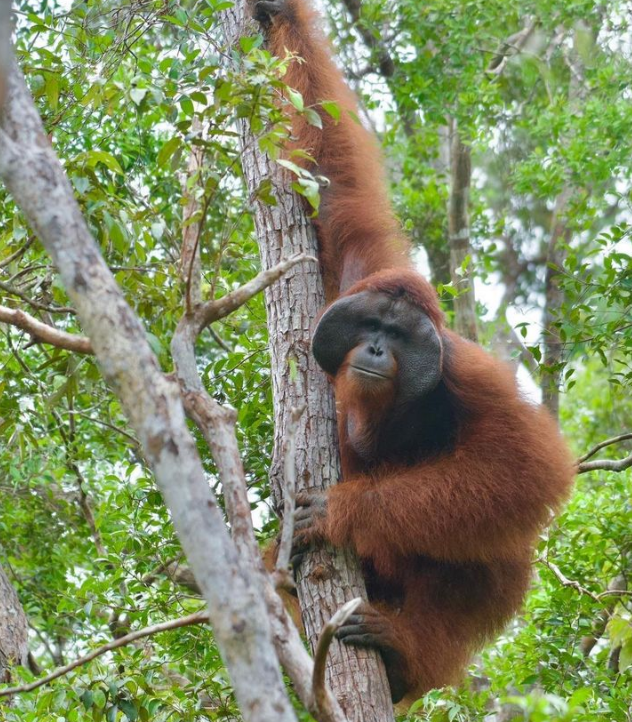The orangutan, known for its distinctive red hair and human-like behavior, is one of the most endangered primate species in the world. Found only on the islands of Sumatra and Borneo, these intelligent and gentle creatures are threatened by habitat loss, poaching, and the illegal pet trade. Conservation efforts are essential to protect the remaining populations of orangutans and ensure the survival of these majestic creatures in the wild.
Orangutans are highly intelligent creatures with exceptional cognitive abilities. They are known to use tools in the wild, such as using sticks to extract insects from trees or creating leafy umbrellas to protect themselves from the rain. In captivity, they have been observed solving puzzles, using sign language to communicate with humans, and displaying a level of self-awareness that is comparable to that of dolphins and chimpanzees

The Ecology of the Orangutan
Orangutans are the largest arboreal mammals, with adult males weighing up to 200 pounds and standing around 5 feet tall. Their long, powerful arms enable them to move through the trees with ease, and they use their four-foot-long arm span to reach branches that are too far away for their legs to reach. Orangutans have long fingers and toes with opposable thumbs, allowing them to grasp objects with great dexterity, making them proficient tool-users. Their hair is a distinct reddish-brown color that fades to gray as they age, with males developing distinctive cheek pads that grow throughout their adult lives.
Orangutans are also incredibly social animals, with complex communication skills and strong family bonds. Female orangutans maintain strong bonds with their offspring, raising them for up to eight years before they become independent. Adult males, on the other hand, are solitary and territorial, only interacting with females during breeding season. While orangutans are generally peaceful, males have been known to display aggressive behavior towards other males, especially during mating season.
Unfortunately, these intelligent creatures are under threat from a variety of human activities, including deforestation, poaching, and the illegal pet trade.
What threatens the Orangutan?
The primary threat to orangutan populations is habitat loss. Deforestation, driven by logging, agriculture, and palm oil plantations, is the most significant cause of habitat destruction in Borneo and Sumatra. In the past few decades, the orangutan’s habitat has been reduced by 80%, leaving the remaining populations confined to small, isolated pockets of forest. This fragmentation makes it difficult for orangutans to find food, mate, and establish social connections, which can lead to a decline in their population numbers.
In addition to habitat loss, orangutans are also threatened by poaching and the illegal pet trade. Orangutan babies are often captured and sold as pets, while adult orangutans are hunted for their meat or body parts, which are used in traditional medicine. Poaching and the illegal pet trade have contributed to a decline in the orangutan population, and it is estimated that only 80,000 orangutans remain in the wild today.
Conservation of the Orangutan
Conservation efforts are essential to protecting orangutan populations and ensuring their survival in the wild. One of the most critical steps in orangutan conservation is habitat protection. Protecting orangutan habitat means preserving the remaining forests where orangutans live, and creating corridors between fragmented forests to enable populations to intermingle and reproduce. It also means reducing the impact of human activities such as logging, agriculture, and palm oil plantations, which are driving deforestation in Borneo and Sumatra.
Another key conservation effort is anti-poaching and law enforcement. Strict laws and regulations must be enforced to prevent illegal hunting and the illegal pet trade. Wildlife rescue and rehabilitation centers are also essential for orangutan conservation, providing a safe haven for rescued orangutans that have been injured or orphaned. These centers help rehabilitate orangutans and prepare them for release back into the wild.
Community engagement is another crucial aspect of orangutan conservation. Local communities play a vital role in protecting orangutan habitat and reducing the impact of human activities on the forest. Engaging with these communities, educating them about orangutans, and empowering them to participate in conservation efforts can help build support for orangutan conservation and reduce the impact of human activities on the forest.
Finally, research is also critical to orangutan conservation efforts. Research can help us understand orangutan behavior, habitat requirements, and population dynamics. This information can be used to inform conservation strategies and ensure the effectiveness of conservation efforts.
Conclusion
In conclusion, orangutans are one of our closest relatives in the wild, and their survival is essential for the health of the planet. Conservation efforts are essential to protect the remaining populations of orangutans and ensure their survival in the wild. Protecting orangutan habitat, anti-poaching efforts, wildlife rescue and rehabilitation, community engagement, and research are all critical components of orangutan conservation. We must work together to ensure the survival of these majestic creatures and protect the biodiversity of the forests they call home.
Help us help them! Think Wildlife Foundation is a non profit organization with various conservation initiatives. Our most prominent campaign is our Caring for Pari intiative. Pari is a rehabilitated elephant at the Wildlife SoS Hospital. 25% of the profits from our store are donated to the elephant hospital for Pari. Other than buying our wonderful merchandise, you could donate directly to our Caring For Pari fundraiser.
Written by: Sanghmitra Singh
